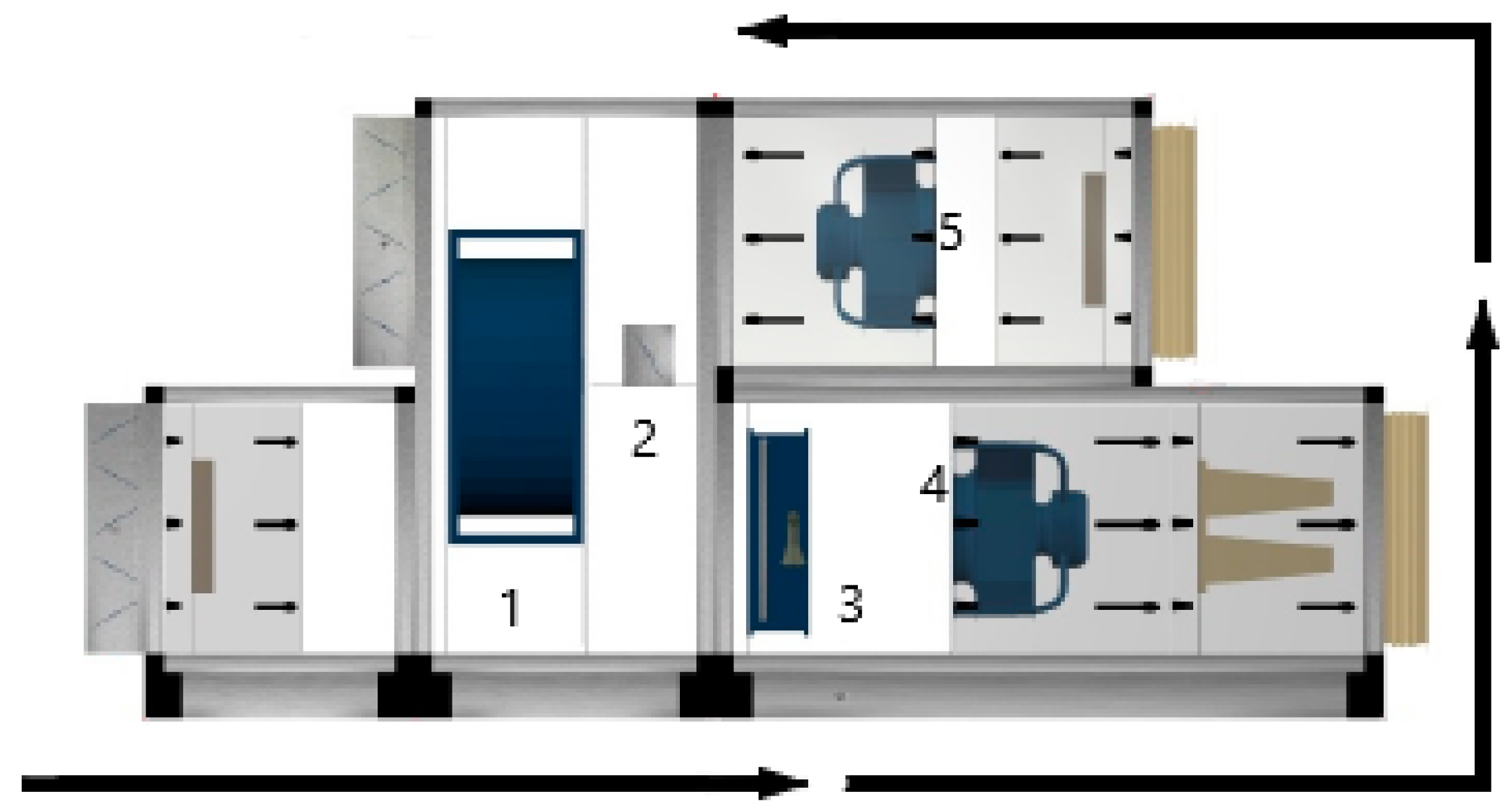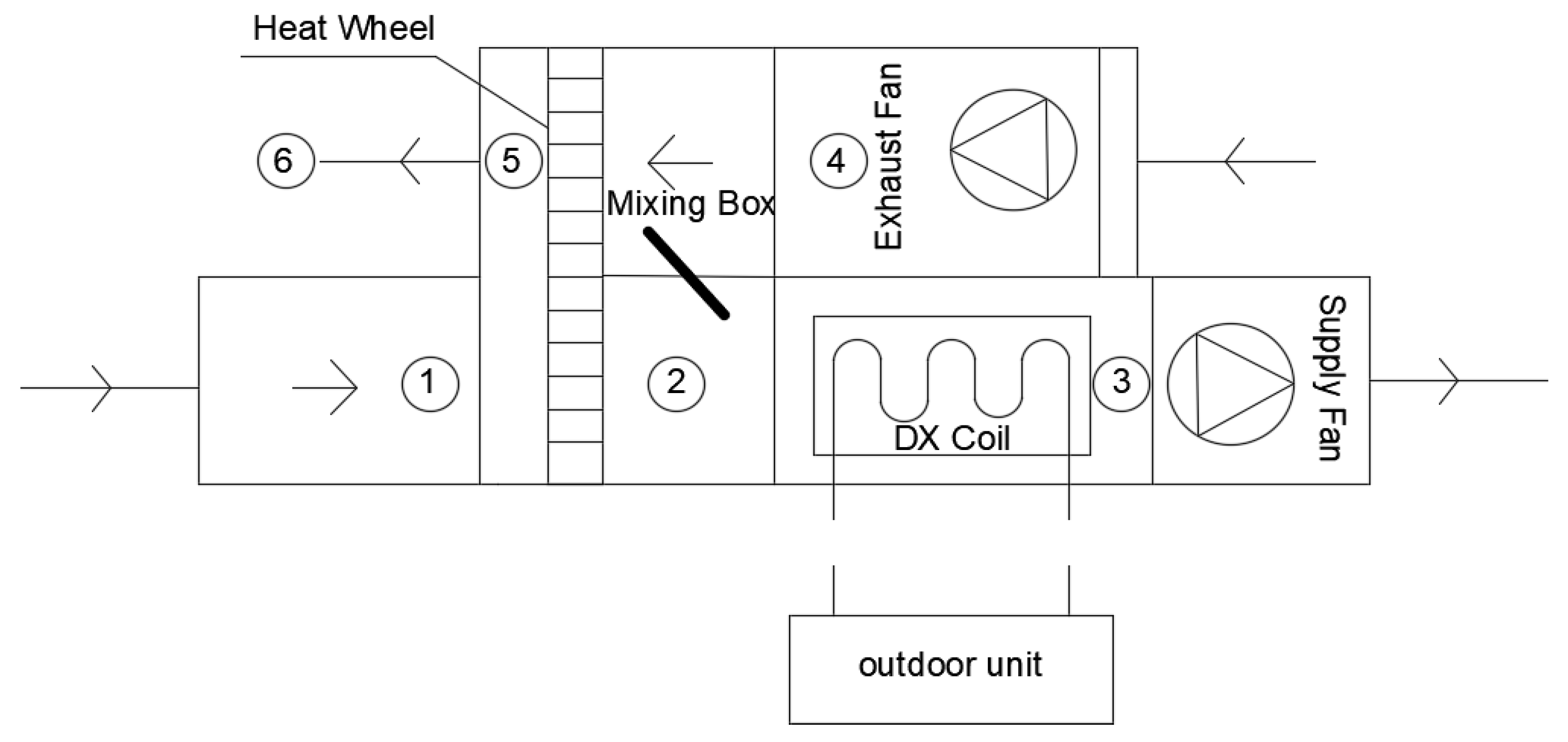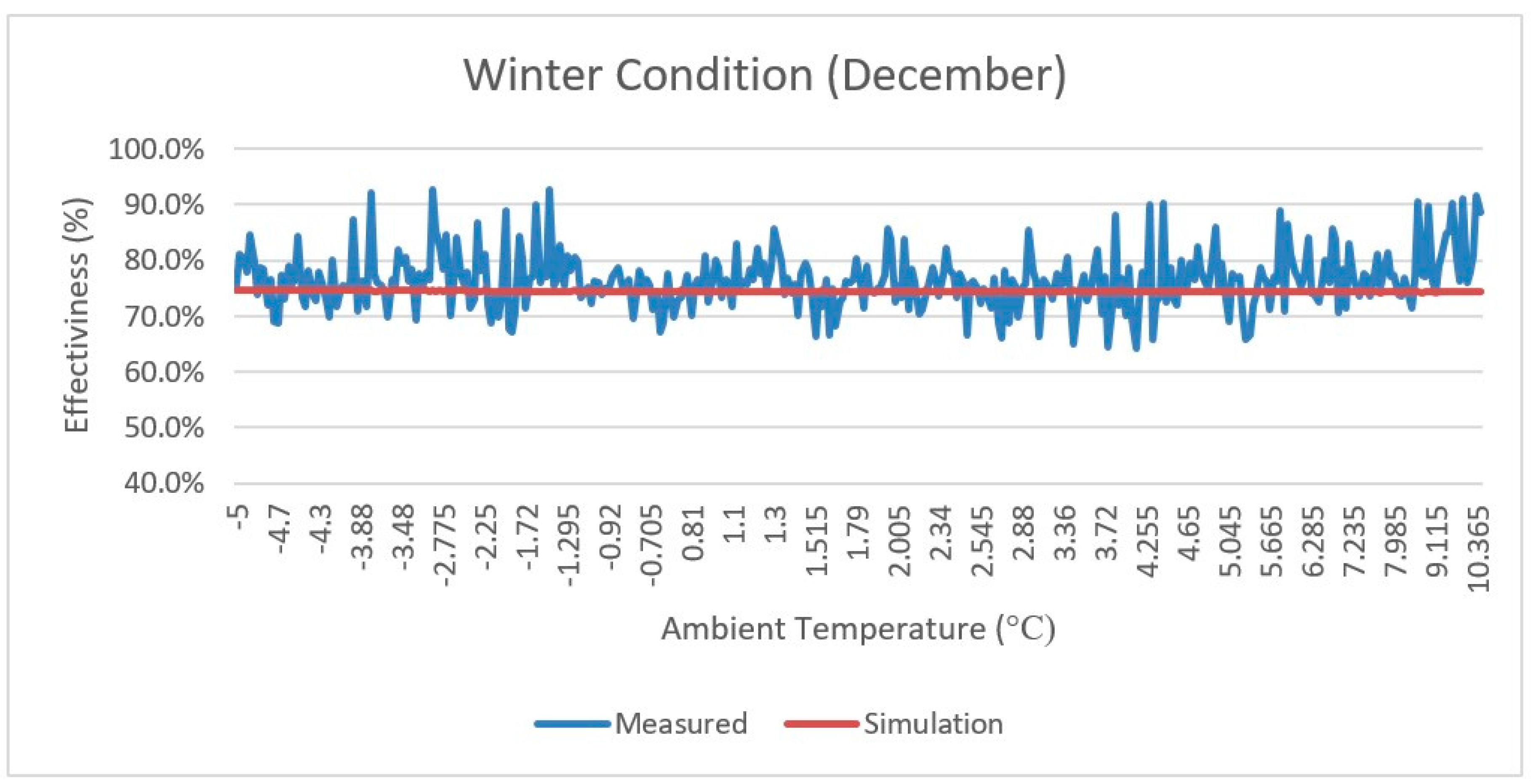Development and Experimental Validation of TRNSYS Simulation Model for Heat Wheel Operated in Air Handling Unit
Abstract
:1. Introduction
2. Description of the Investigated AHU
3. Description of the Used Mathematical Model
4. Description of the Developed TRNSYS Simulation Model
5. Model Validation
6. Results and Discussion
7. Conclusions
- (1)
- The analysis of the supply air condition (fresh air inlet) of the heat wheel showed that the system can save energy in different weather conditions and it is more useful than the conventional air conditioning systems.
- (2)
- The change in the fresh inlet temperature air has a major influence on the system performance. The performance of the AHU air-conditioning system can be further enhanced by equipping a sorption wheel for the supply of regeneration energy to maximize the energy savings by transfer of the humidity air from the extract air.
- (3)
- The sensible effectiveness values of the heat wheel measured were higher than the simulated data in summer, whereas it was lower in winter.
- (4)
- The simulation value of sensible effectiveness showed a constant trend that was close to the given effectiveness values in the technical data sheet of the producer (74.9%).
- (5)
- The NMBE and CVRMSE used to validate the model showed that the TRNSYS model has an acceptable range as the criteria for NMBE and CVRMSE are less than 10% and 30%, respectively. The developed TRNSYS model can be useful for predicting the performance of such extreme conditions.
Author Contributions
Funding
Acknowledgments
Conflicts of Interest
Nomenclature
| Abbreviations | |
| h | Enthalpy (kJ/kg) |
| Air mass flow rate (kg/h) | |
| RH | Relative Humidity (%) |
| Q | Heat Capacity (kW) |
| Power Consumption (kW) | |
| T | Temperature (°C) |
| Air volume flow rate (m3/h) | |
| VRV | Variable Refrigerant Flow |
| AHU | Air Handling Unit |
| HWR | Heat Wheel Recovery |
| COP | Coefficient of Performance |
| Greek Letters | |
| ε | effectiveness |
| τ | time (h) |
| Density of the air (kg/m3) | |
| Specific heat capacity (kJ/kg °C) | |
| Subscripts | |
| Ei | Exhaust air inlet |
| o | Outdoor |
| Si | Supply air inlet |
| So | Supply air outlet |
| ss | supply air in summer |
| es | exhaust air in summer |
| sw | supply air in winter |
| ew | exhaust air in winter |
| s | Sensible |
References
- Kassai, M.; Al-Hyari, L. Experimental investigation on operation parameters of 3Å molecular sieve desiccant coated total energy recovery wheel for maximum effectiveness. Therm. Sci. 2020, 24, 2113–2124. [Google Scholar] [CrossRef] [Green Version]
- Wan, K.K.W.; Li, D.H.W.; Liu, D.; Lam, J.C. Future trends of building heating and cooling loads and energy consumption in different climates. Build. Environ. 2011, 46, 223–234. [Google Scholar] [CrossRef]
- Ahmed, K.; Carlier, M.; Feldmann, C.; Kurnitski, J. A New Method for Contrasting Energy Performance and Near-Zero Energy Building Requirements in Different Climates and Countries. Energies 2018, 11, 1334. [Google Scholar] [CrossRef] [Green Version]
- Jani, D.B.; Mishra, M.; Sahoo, P.K. Performance studies of hybrid solid desiccant - vapor compression air-conditioning system for hot and humid climates. Energy Build. 2015, 102, 284–292. [Google Scholar] [CrossRef]
- Jörgen, W.; Joachim, C. Improving heat recovery using retrofitted heat pump in air handling unit with energy wheel. Appl. Therm. Eng. 2014, 64, 823–829. [Google Scholar]
- Zendehboudi, A.; Hashemi, R. A Study on the Performance of a Solar Desiccant Cooling System by TRNSYS in Warm and Humid Climatic Zone of IRAN. Int. J. Adv. Sci. Technol. 2014, 69, 13–18. [Google Scholar] [CrossRef]
- Bareschino, P.; Pepe, F.; Roselli, C.; Sasso, M.; Tariello, F. Desiccant-based air handling unit alternatively equipped with three hygroscopic materials and driven by solar energy. Energies 2019, 12, 1543. [Google Scholar] [CrossRef] [Green Version]
- Rasouli, M.; Simonson, C.J.; Besant, R.W. Applicability and optimum control strategy of energy recovery ventilators in different climatic conditions. Energy and Buildings. 2010, 42, 1376–1385. [Google Scholar] [CrossRef]
- Rasouli, M.; Akbari, S.; Simonson, C.J.; Besant, R.W. Energetic, economic and environmental analysis of a health-care facility HVAC system equipped with a run-around membrane energy exchanger. Energy Build. 2014, 69, 112–121. [Google Scholar] [CrossRef]
- TRNSYS. Trnsys 17—Input—Output—Parameter Reference, A Transient System Simulation Program User’s Manual. Solar Energy Laboratory, University of Wisconsin, Madison, 2011. Available online: http://web.mit.edu/parmstr/Public/TRNSYS/04-MathematicalReference.pdf (accessed on 18 September 2020).
- Speerforck, A.; Schmitz, G. Experimental investigation of a ground-coupled desiccant assisted air conditioning system. Appl. Energy 2016, 181, 575–585. [Google Scholar] [CrossRef] [Green Version]
- Jani, D.B.; Mishra, M.; Sahoo, P.K. Performance analysis of a solid desiccant assisted hybrid space cooling system using TRNSYS. J. Build. Eng. 2018, 19, 26–35. [Google Scholar] [CrossRef]
- De Antonellis, S.; Intini, M.; Joppolo, C.M.; Leone, C. Design Optimization of Heat Wheels for Energy Recovery in HVAC Systems. Energies 2014, 7, 7348–7367. [Google Scholar] [CrossRef] [Green Version]
- Kassai, M. Energy Performance Investigation of a Direct Expansion Ventilation Cooling System with a Heat Wheel. Energies 2019, 12, 4267. [Google Scholar] [CrossRef] [Green Version]
- ASHRAE Standard. Standard 84-1991, Method of Testing Air-to-Air Heat Exchangers; American Society of Heating, Refrigerating and Air Conditioning, Engineers Inc.: Atlanta, GA, USA, 1991. [Google Scholar]
- Hong, T.; Sun, K.; Zhang, R.; Hinokuma, R.; Kasahara, S.; Yura, Y. Development and validation of a new variable refrigerant flow system model in EnergyPlus. Energy Build. 2016, 117, 399–411. [Google Scholar] [CrossRef] [Green Version]
- Granderson, J.; Touzani, S.; Custodio, C.; Sohn, M.; Fernandes, S. Assessment of Automated Measurement and Verification (M&V) Methods; Building Technology and Urban Systems Division, Lawrence Berkeley National Laboratory: Berkeley, CA, USA, 2015. [Google Scholar]
- American Society of Heating, Ventilating, and Air Conditioning Engineers (ASHRAE). Guideline 14-2014, Measurement of Energy and Demand Savings; Technical Report; American Society of Heating, Ventilating, and Air Conditioning Engineers: Atlanta, GA, USA, 2014. [Google Scholar]












| Parameter | Value | Unit |
|---|---|---|
| Length Overall | 2897 | mm |
| Insulation | Foam | - |
| Duct Supply (Width × Height) | 1370 × 540 | mm |
| Total heating capacity | 12.3 | kW |
| Total cooling capacity | 10.9 | kW |
| COP (Coefficient of Performance) | 5.56 | - |
| EER (Energy Efficiency Ratio) | 3.99 | - |
| Evaporating Temperature | 6 | °C |
| Heat Wheel Type | Sensible | % |
| Heat Wheel Effectiveness | 74.9 | % |
| Heat Wheel Pressure drop | 80 | Pa |
| Heat Wheel Power | 12 | kW |
| Device | Parameter | Value | Unit |
|---|---|---|---|
| Supply Fan | Type | Centrifugal Fan | - |
| Total Static Pressure | 619 | Pa | |
| Flow Design | 2250 | m3/h | |
| Rated Power | 0.7 | kW | |
| Return Fan | Type | Centrifugal Fan | - |
| Total Static Pressure | 473 | pa | |
| Flow Design | 1850 | m3/h | |
| Rated Power | 0.49 | kW |
| Device | Working Range | Accuracy |
|---|---|---|
| Temperature Sensor | −40 to 150 °C | ±0.4 °C |
| Humidity Sensor | 10–90% | ±3% |
| Air velocity Sensor | 2–20 m/s | ±0.2 m/s |
| Electricity energy meter | 5–100 A | ±1% |
| Total Energy Consumption | NMBE (%) | CVRMSE (%) | |
|---|---|---|---|
| Heating Measured Total (kWh) | 6342 | 5.5% | 19% |
| Heating Simulation Total (kWh) | 6753 | ||
| Cooling Measured Total (kWh) | 2034 | 7% | 24% |
| Cooling Simulation Total (kWh) | 1864 |
© 2020 by the authors. Licensee MDPI, Basel, Switzerland. This article is an open access article distributed under the terms and conditions of the Creative Commons Attribution (CC BY) license (http://creativecommons.org/licenses/by/4.0/).
Share and Cite
Al-Hyari, L.; Kassai, M. Development and Experimental Validation of TRNSYS Simulation Model for Heat Wheel Operated in Air Handling Unit. Energies 2020, 13, 4957. https://doi.org/10.3390/en13184957
Al-Hyari L, Kassai M. Development and Experimental Validation of TRNSYS Simulation Model for Heat Wheel Operated in Air Handling Unit. Energies. 2020; 13(18):4957. https://doi.org/10.3390/en13184957
Chicago/Turabian StyleAl-Hyari, Laith, and Miklos Kassai. 2020. "Development and Experimental Validation of TRNSYS Simulation Model for Heat Wheel Operated in Air Handling Unit" Energies 13, no. 18: 4957. https://doi.org/10.3390/en13184957
APA StyleAl-Hyari, L., & Kassai, M. (2020). Development and Experimental Validation of TRNSYS Simulation Model for Heat Wheel Operated in Air Handling Unit. Energies, 13(18), 4957. https://doi.org/10.3390/en13184957





